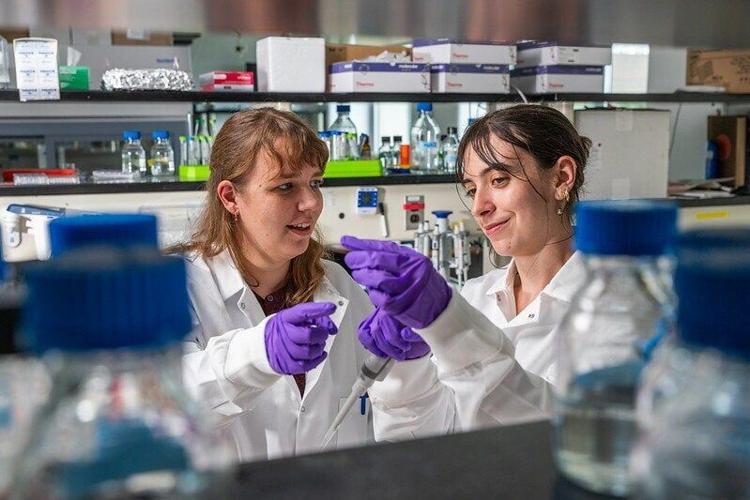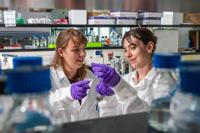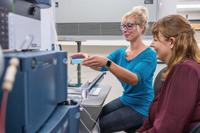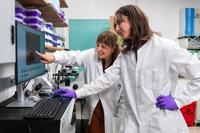
In the Balbach lab, researchers like graduate student Macy Jenks (R) are helping push the boundaries of reproductive metabolism. (Finn Gomez & Paul Henderson via SWNS)
By Stephen Beech
A major discovery has paved the way for a male contraceptive pill, say scientists.
The molecular “switch” that "supercharges" sperm for their final sprint to an egg has been pinpointed by American researchers.
They say their findings could "reshape" infertility treatments and opened the door to safe, non-hormonal male contraceptives.
Study senior author Dr. Melanie Balbach said: "Sperm metabolism is special since it’s only focused on generating more energy to achieve a single goal: fertilisation."
She explained that, before ejaculation, mammalian sperm rest in a low-energy state.
Afterwards, as they swim through the female reproductive tract, they undergo a series of changes that ultimately help them reach and fertlize an egg.

(Photo by Yan Krukau via Pexels)
These include swimming with quick, vigorous movements, as well as a change to the membranes that will encounter an egg.
Dr. Balbach, an Assistant Professor in the department of biochemistry and molecular biology at Michigan State University, said: “Many types of cells undergo this rapid switch from low to high energy states, and sperm are an ideal way to study such metabolic reprogramming."
She says metabolism is similarly essential for sperm function, and while scientists knew that behavioural changes before fertilisation required a large amount of energy, they weren’t sure how sperm adjusted to meet the demand — until now.
Dr. Balbach’s team created a special technique that allowed them to track the metabolism of glucose, which sperm take up from their environment and use as a sort of fuel.
By tracing the chemical journey of glucose within sperm, they observed "key differences" between dormant and active specimens.

Graduate student Nikki Deiro (L) and Balbach run samples at MSU's Mass Spectrometry and Metabolomics Core. (Finn Gomez & Paul Henderson via SWNS)
Dr. Balbach said: “You can think of this approach like painting the roof of a car bright pink and then following that car through traffic using a drone.
“In activated sperm, we saw this painted car moving much faster through traffic while preferring a distinct route and could even see what intersections the car tended to get stuck at."
She says the study, published in the journal Proceedings of the National Academy of Sciences, paints a fuller picture of the high-energy, multiple-step process required for sperm to reach their fertilisation goal.
These includes the discovery that a particular enzyme called aldolase helps sperm convert glucose into energy and that sperm even utilize molecular fuel that they already have on board when they begin their trek.
The experiments also revealed how some enzymes regulate the flow of glucose like traffic controllers.
Dr. Balbach plans to continue exploring how sperm use a variety of fuel sources - such as glucose and fructose - to meet their energy needs.

(Photo by Pixabay via Pexels)
She says the research can potentially impact several reproductive health issues.
With one in six people impacted by infertility globally, Dr. Balbach sees the analysis of sperm metabolism as an especially promising research direction for improving both assisted fertility techniques and the diagnosis of infertility in patients.
She says the work can also help develop new methods of contraception.
Dr. Balbach said: “Better understanding the metabolism of glucose during sperm activation was an important first step, and now we’re aiming to understand how our findings translate to other species, like human sperm.
“One option is to explore if one of our ‘traffic-control’ enzymes could be safely targeted as a nonhormonal male or female contraceptive."
She says the traditional development of male contraceptives has focused on blocking sperm at their creation.

Using a special microscope, Melanie Balbach (L) and undergrad research assistant Lana Kouatli are able to track the quantities and motility of sperm in a particular sample. (Finn Gomez & Paul Henderson via SWNS)
But that approach has notable drawbacks as such contraceptives are commonly hormone-based, leading to many severe side effects.
Dr. Balbach says the latest findings pave the way for a sperm metabolism-based solution - a non-hormonal method of contraception that would allow for on-demand male infertility with little to no side effects.
She said: “Right now, about 50% of all pregnancies are unplanned, and this would give men additional options and agency in their fertility.
“Likewise, it creates freedom for those using female birth control, which is hormone-based and highly prone to side effects."
Dr. Balbach added: “I’m excited to see what else we can find and how we can apply these discoveries.”























(0) comments
Welcome to the discussion.
Log In
Keep it Clean. Please avoid obscene, vulgar, lewd, racist or sexually-oriented language.
PLEASE TURN OFF YOUR CAPS LOCK.
Don't Threaten. Threats of harming another person will not be tolerated.
Be Truthful. Don't knowingly lie about anyone or anything.
Be Nice. No racism, sexism or any sort of -ism that is degrading to another person.
Be Proactive. Use the 'Report' link on each comment to let us know of abusive posts.
Share with Us. We'd love to hear eyewitness accounts, the history behind an article.